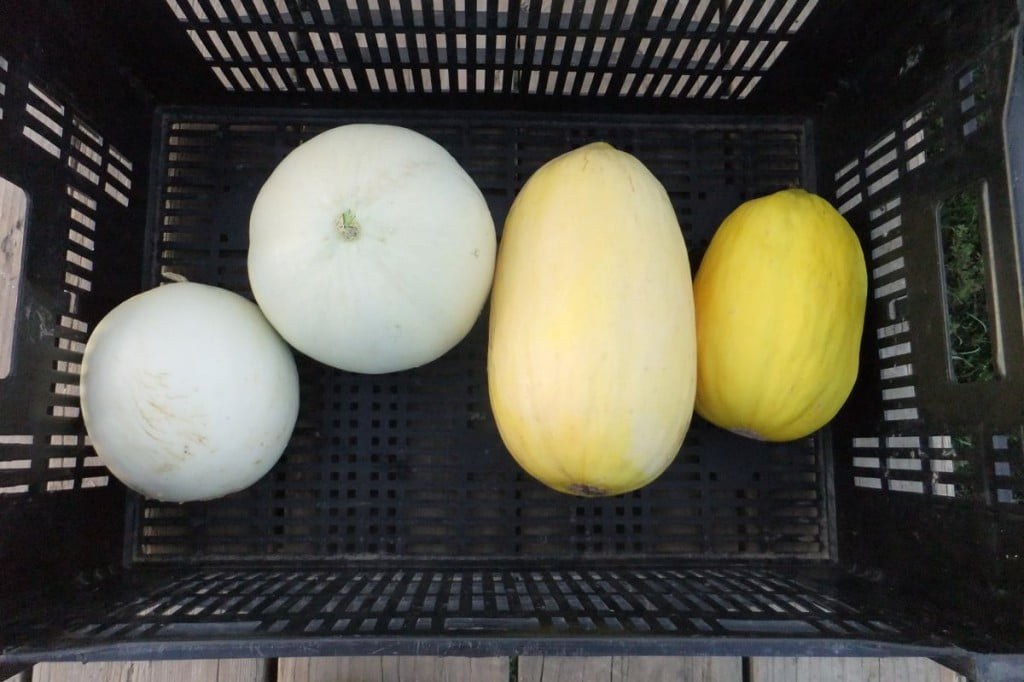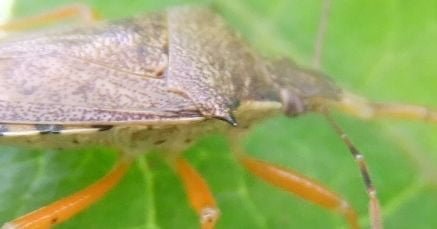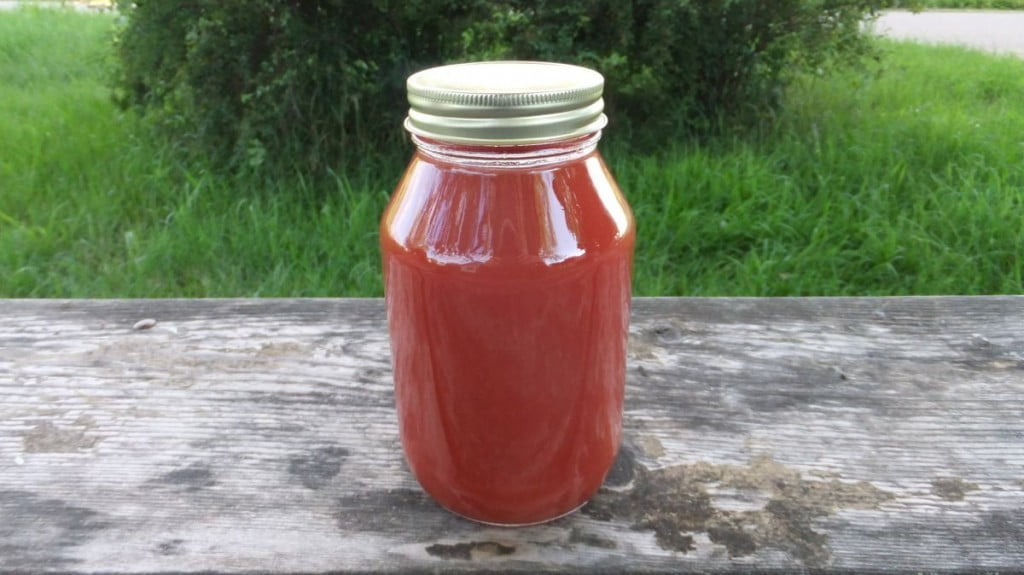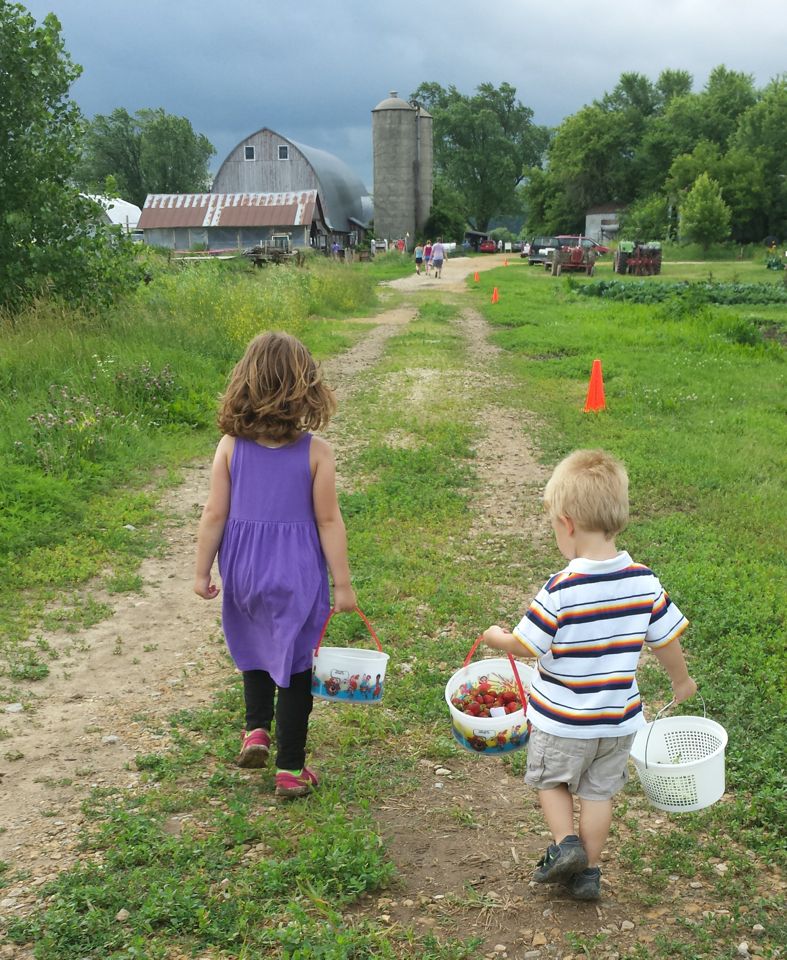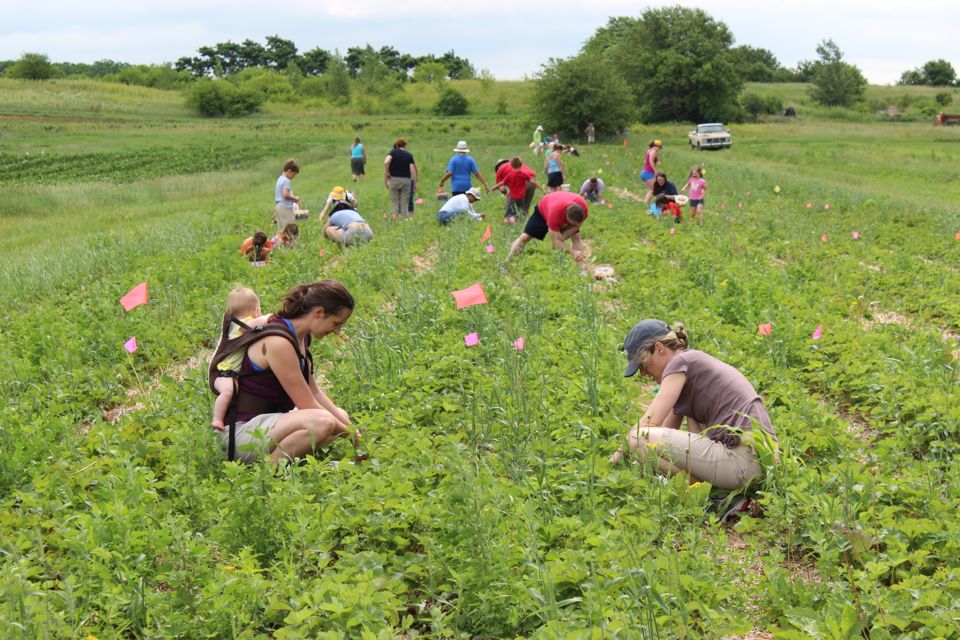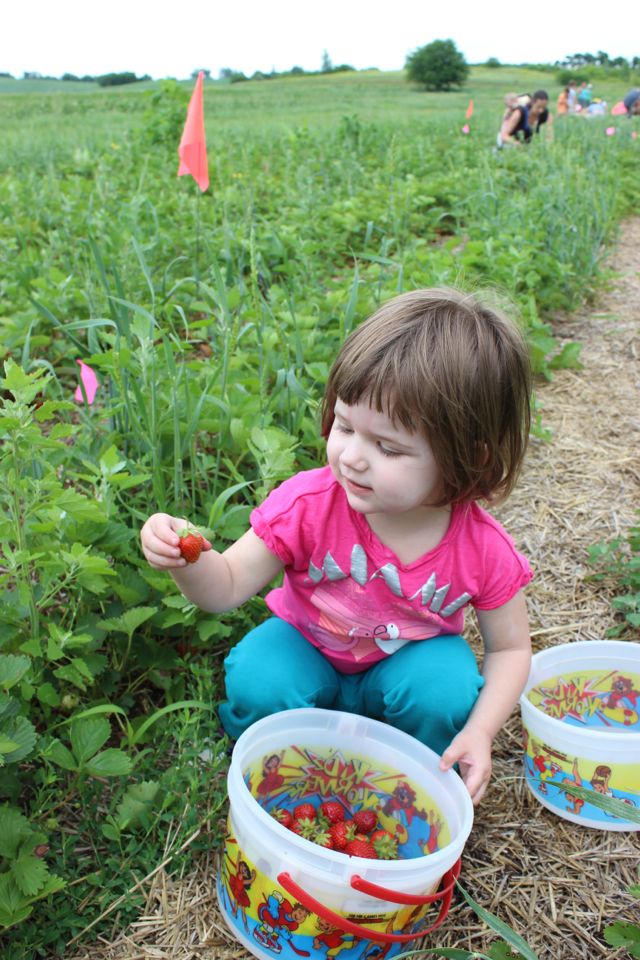Blog
The challenges of a bumper crop
- On: September 03, 2014
 0
0
This is absolute peak season. We have five coolers running right now, and each is full the night before deliveries. The trucks are stuffed. Our hard-working crew has kicked into high gear. These peaks are inevitable and desirable. How do we handle these moments? Here are our ‘pressure valves’, our strategies to make good use of abundant produce:
- First, we stuff the CSA boxes. We want to share as much as we can with you members. This week’s box is full and heavy again. Fortunately, it’s summer produce that everyone loves.
- Steve encourages our store customers to put abundant items on sale. For example, Willy Street Coop has our watermelons on sale this week.
- We sell extra produce to you folks. This is the time of year when we can spare some tomatoes and peppers from the CSA boxes. Freeze or can them and enjoy in winter.
- We donate less-than-perfect produce to Second Harvest Foodbank, which distributes it to food pantries, soup kitchens and families in need.
- We are going to can tomato juice again this year! That will consume 1500 lb ripe tomatoes, and means there will be tomato juice in your CSA boxes next year. This is a great way to capture perishable tomatoes at peak flavor.
- We find ourselves with an abundance of round watermelons over 25 lb. Not even the stores will take melons this big. We are donating 1000 lb of these melons to FairShare’s Bike the Barns fundraiser so they can feed them to thirsty bicyclists.
.
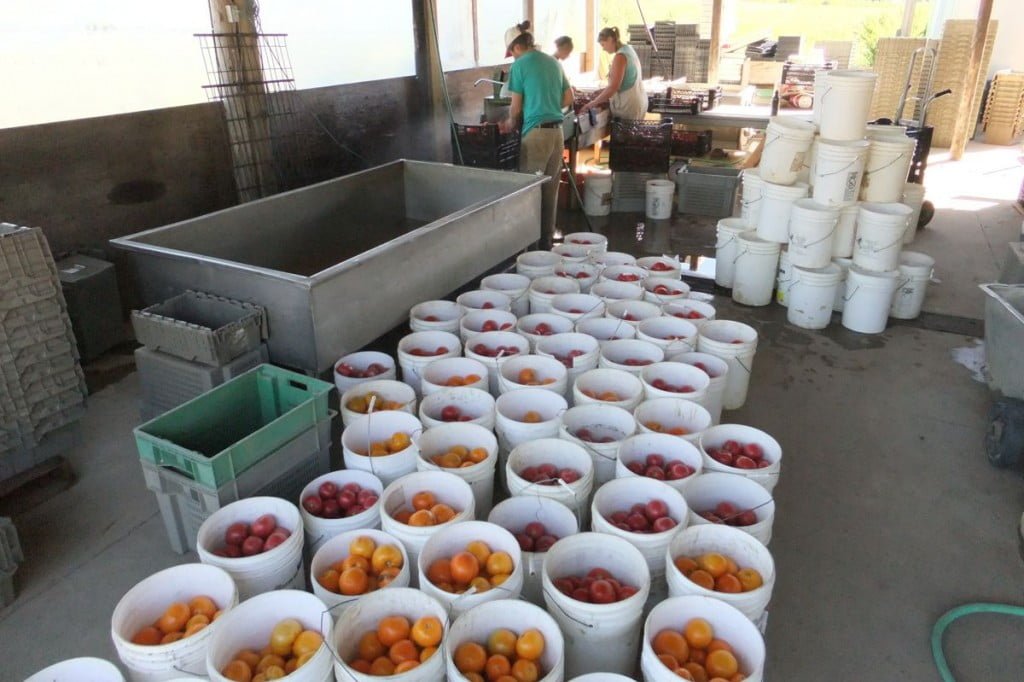
A sea of tomatoes for the CSA boxes. At back, Jory, Boi and Maggie wash tomatoes.
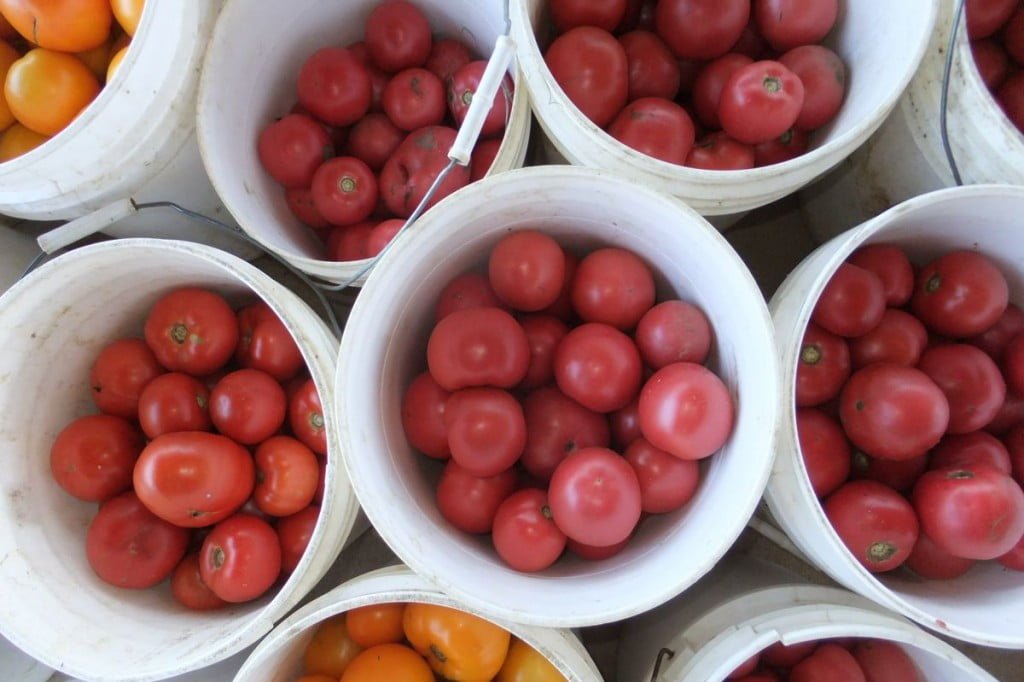
Yellow, red, and pink slicing tomatoes, ready to be washed.
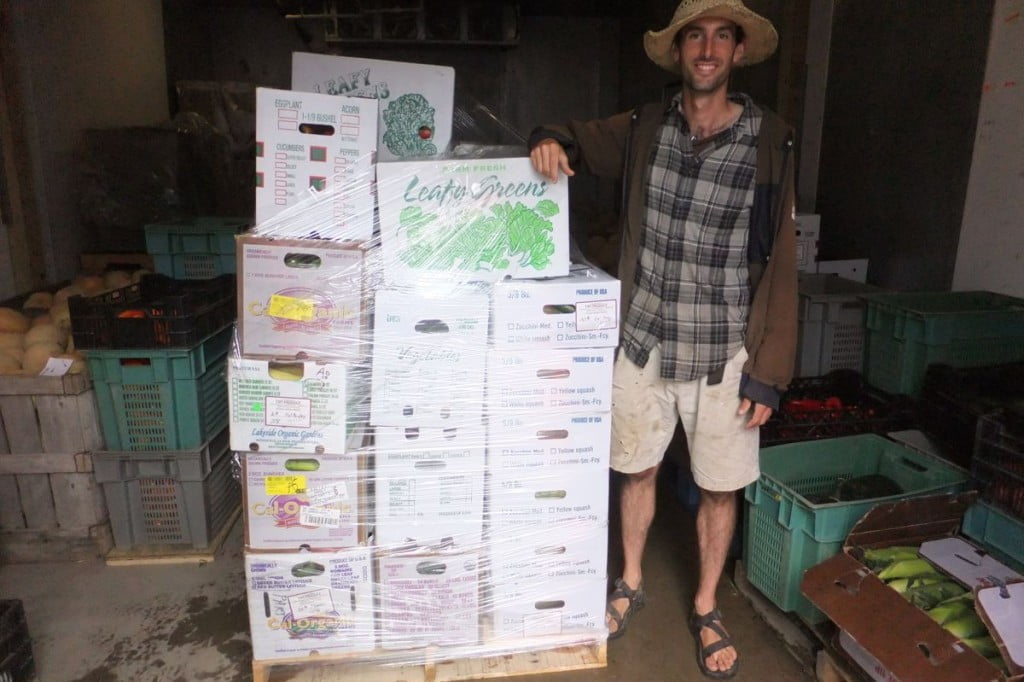
Our packshed manager Jon with a donation ready for Second Harvest. We donate #2 grade produce each week.
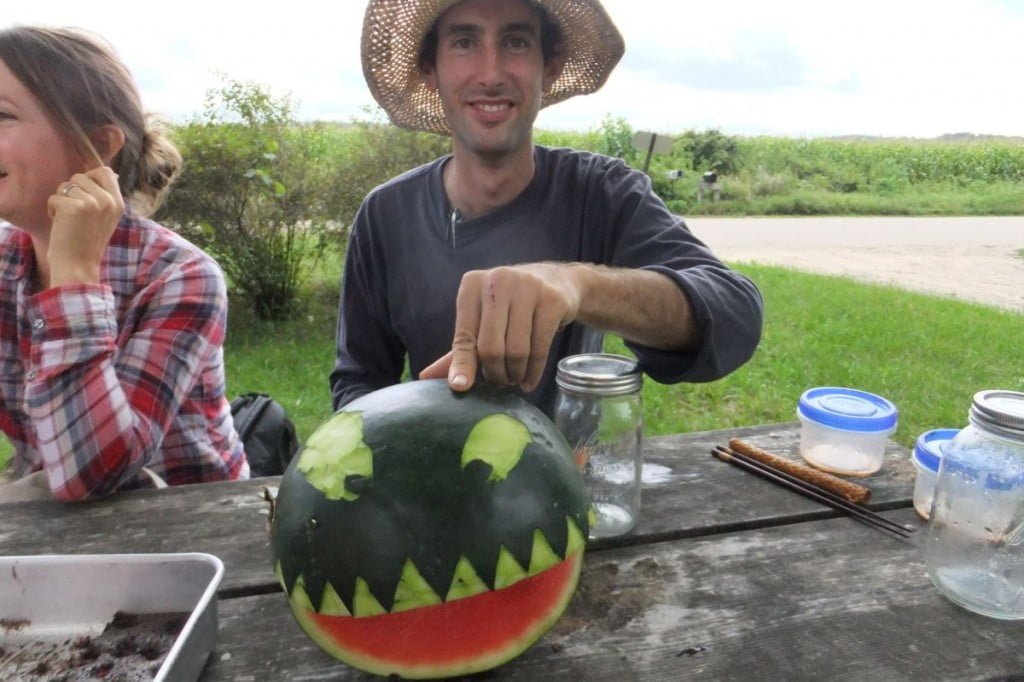
Finally, we try to be creative with our excess produce. Jon and friend, with Karen at left.
Veggie list and veggie notes (9/4/14, week #16, purple EOW)
Red watermelon
Sweet corn, 4 or 5 ears
Cauliflower OR edamame soybeans OR cherry tomatoes
Red frying peppers, about 2
Orano peppers, about 3
Poblano chiles, 3
Slicing tomatoes, 3.5 lb
Leeks, about 1.5 lb
Garlic
Basil, 1 sprig
Zucchini, 1
An heirloom tomato OR cherry tomatoes
Next week’s box is likely to contain red cabbage, red potatoes, garlic, cauliflower or broccoli, lettuce, scallions, peppers, tomatoes and more.
Watermelon – This is probably the last melon. We have simply run out of melons that will fit in the CSA boxes, plus the fall produce is ripening. You can still buy our large melons at Willy Street Coop, Outpost Natural Foods, Basics Coop and Paoli Natural Foods. We will supply them with melons for a few more weeks.
Sweet corn – This sweet corn variety is not particularly sweet. It’s a new variety for us. However, the ears are big and the flavor is terrific. This corn is excellent cut from the cob and added to dishes. We tried three new sweet corn varieties this year because our standard variety was not available this year. This one was very productive but I think we’ll look for sweeter varieties next year.
Edamame soybeans (bundle of stems with pods) – It was not an abundant year for edamame. Only one spring planting survived, sparsely. We’ll try again next year.
These edible soybeans are a treat. Pull the pods from the stem and wash well. It helps to submerge the pods and rub them together. Boil in water until the pods have split and the beans are quite tender. Season with salt and pop the beans out of the pods into your mouth. This Japanese specialty is becoming more and more popular in the USA.
Storage: Remove the pods from the stems promptly and refrigerate.
Red frying peppers and Orano (orange) peppers – These peppers are all sweet. Some of these peppers may be part green and part red (or part orange). You can distinguish them from the spicier poblanos because the poblanos are solid green.
Poblano chiles (dark green, shiny, triangular) – These chiles have low-to-medium heat and great flavor. Most I’ve cooked so far this year are milder than usual, but a few were corkers.
Leeks (look like big scallions) – These alliums have a milder flavor than onions. Nonetheless, they can be used in recipes that call for onions. To wash, split the leek lengthwise, from the green tops about halfway to the base, leaving the base intact. Rinse well under running water, separating the layers to flush. If necessary, split the leek further if soil has penetrated more than halfway down the leek. Shake dry. Leeks are generally eaten cooked. They can be sauteed, steamed or roasted. Intact leeks will store 2 to 3 weeks if covered loosely and refrigerated. The outer leaves will yellow. Just peel them off and discard. The inner leek layers will be fine.
Garlic – This batch is from John Hendrickson of Stone Circle Farm again.
Basil – We’re sending another small sprig of Thai basil. It is tolerant to the downy mildew disease spreading across Wisconsin, so we still have a small amount to share.
Heirloom tomatoes (large tomato that’s not in the paper bag with the other tomatoes) – Heirloom tomatoes are full-flavored but delicate. If you receive one this week, please handle it gently. These fragile beauties bruise easily. You might have to ripen your heirloom tomato at room temperature for a day or two. Don’t let it get overripe.
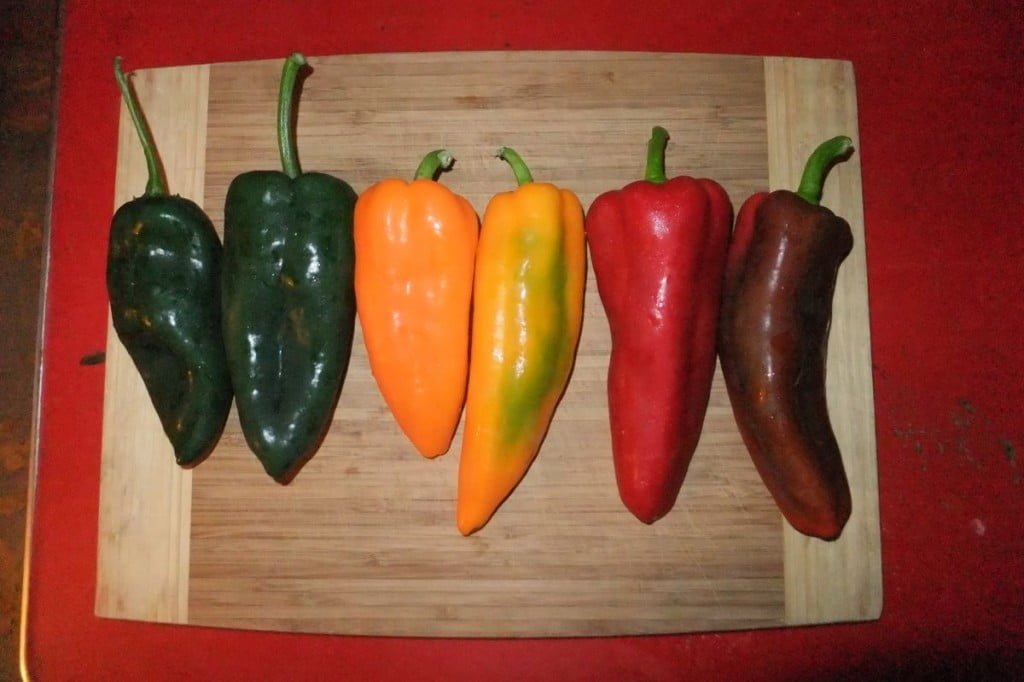
Poblanos (left, low-to-medium heat), Oranos (center, sweet), and red frying peppers (right, sweet). The Oranos and frying peppers might have a bit of green. The poblanos will be all green so you can recognize them.
Water on, water off
- On: August 27, 2014
 0
0
We had too much water and too little water at the same time on Monday. A thunderstorm brought two inches of rain in about 45 minutes. That’s fast. Everyone worked indoors for an hour before heading out into the mud. Only one truck got mired! Meanwhile, a nearby lightning strike damaged the electronic control for our farmstead well. A broken well means we cannot wash produce. This is a big problem on a muddy day. We continued harvesting while our well expert Charlie Davis diagnosed the problem, gathered the parts, and got it fixed. By afternoon we could start washing. That was a full, busy day.
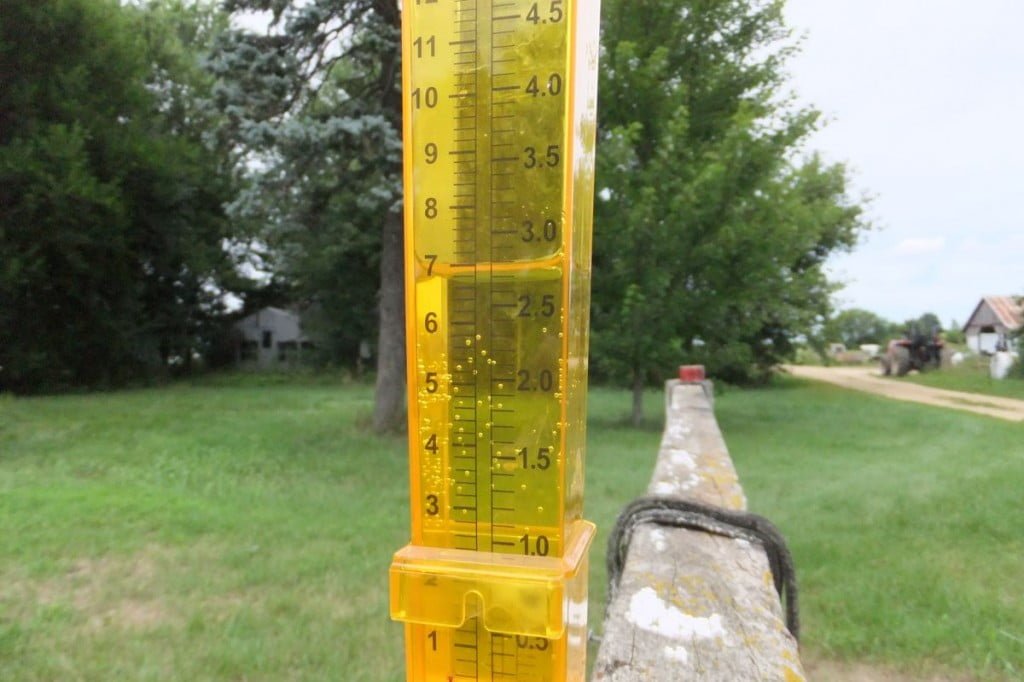
A total of 2.7 inches rain fell on Monday and Tuesday.

Steve checks electrical components in our well house.
Melon harvest is at its peak so we are sending two melons this week. Read below about the types. Enjoy them over the Labor Day holiday. This was a demanding week for Steve, as he picks and throws every watermelon. He estimates he picked 19,000 lb of watermelons and honeydew melons this week. Right now, he’s lying down on the floor to rest. A second crew, led by Michael and Billy, takes care of the muskmelons and crenshaws. The melon crews love this work. It’s fast-paced and productive, and they get to eat any dropped melons. Still warm from the sun, they are luscious.
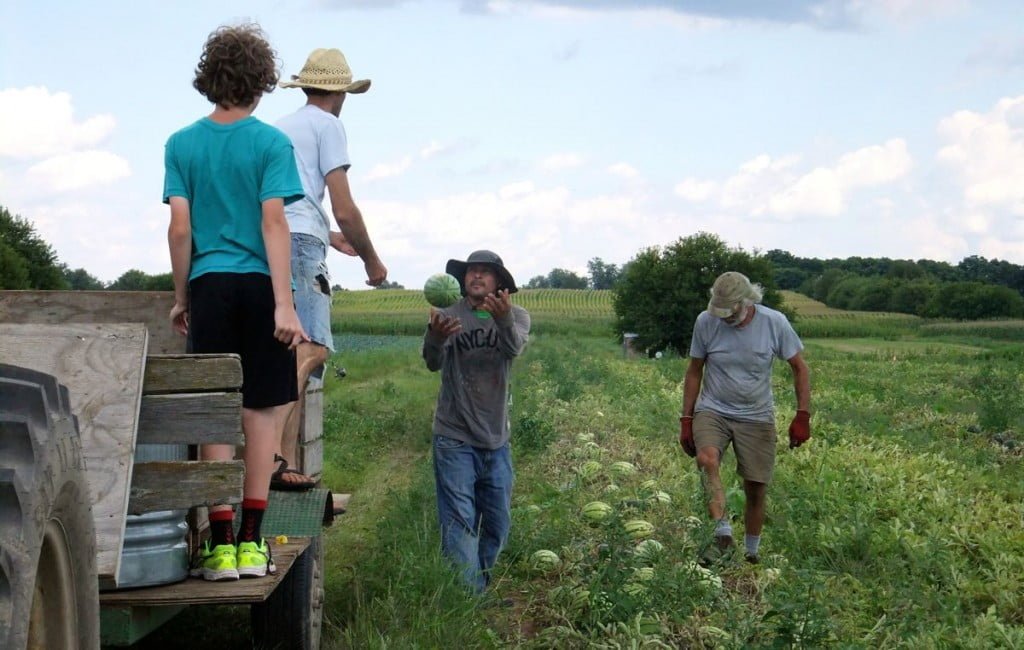
Melon harvest. From right, Steve chooses ripe melons then tosses them to Edgar, who tosses to Jon, who tosses to Ari, who washes the melons in a tank on the wagon.
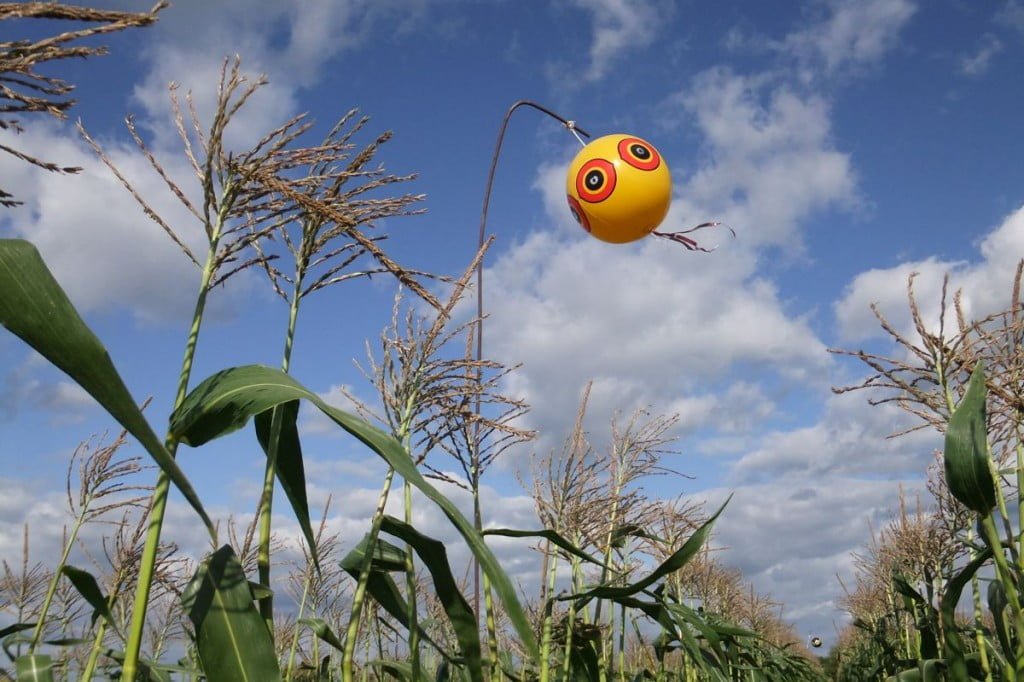
A modern scare crow protects the corn. The final sweet corn will be ready next week.
Veggie list (August 28/29, 2014, week #15, green EOW)
This is another full, heavy box. Carry your box from the bottom so it doesn’t break open. We’ll send everything on this list, as long as it fits in the box.
Orange watermelon
Crenshaw OR honeydew melon
Sweet corn, about 6 ears
Slicing & plum tomatoes, 3.75 – 4.0 lb
Colored bell pepper, 1 or 2
Orano pepper, 1 or 2
Yellow onions, 1 or 2
Cucumber (1 or 2) OR pickles
Lacinato OR Red Russian kale, 1 bunch
Dillweed, 1 stalk
Some sites will get eggplant. Some will get an heirloom tomato.
Next week’s box will probably contain red potatoes, sweet corn, leeks, tomatoes, peppers, poblano chiles, and more.
Tomatoes – All the tomatoes are in one bag. Here’s the breakdown: plum tomatoes, about 1 lb; slicing tomatoes, about 2.75 – 3 lb.
Yellow onions – We are sending yellow onions for the first time this year. These are pungent cooking onions, good for frying. We’ll switch back to sweet Walla Wallas over the next few weeks, so keep them segregated if you carry onions from week to week.
Cucumbers – There are a few oddly-shaped cucumbers this week. The cucumber season won’t last much longer, and we’re eager to send them while we have them. They are still delicious.
Melon ID (crenshaw vs honeydew), plus how to judge ripeness.
Orange watermelons – Round or slightly oblong, with the usual variegated watermelon ride. These are ripe. Eat soon.
Crenshaw melons – This oblong melon has a yellow exterior. The interior is pale orange with a soft, creamy texture, similar to muskmelon. These melons were ripe or nearly ripe when harvested but will improve after a day or two on your countertop. The end opposite the stem scar should be slightly soft when pressed. Refrigerate at this stage of ripeness.
Honeydew melons – This melon has an off-white rind, and a pale green interior. Most are round. We picked most of these melons slightly under-ripe to avoid the cracking that often ruins an otherwise good crop. Let your honeydew sit at room temperature for one to four days, until it softens slightly at the end opposite the stem. Feel your honeydew the day you bring it home, so you can recognize once it softens a bit. Honeydews without an attached stem will ripen sooner than those with a cut stem piece.
Out with the old, in with the new.
- On: August 20, 2014
 0
0
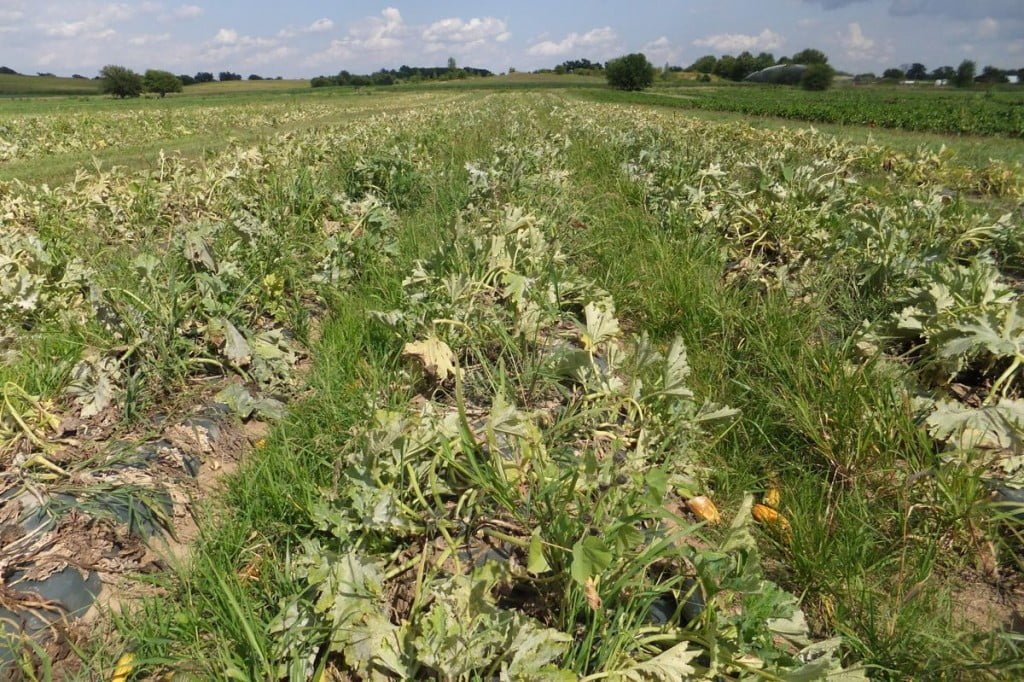
We recently retired our first zucchini and summer squash planting. The field was productive for two months but now the plants are exhausted and the field is overrun with weeds, bugs, diseases.
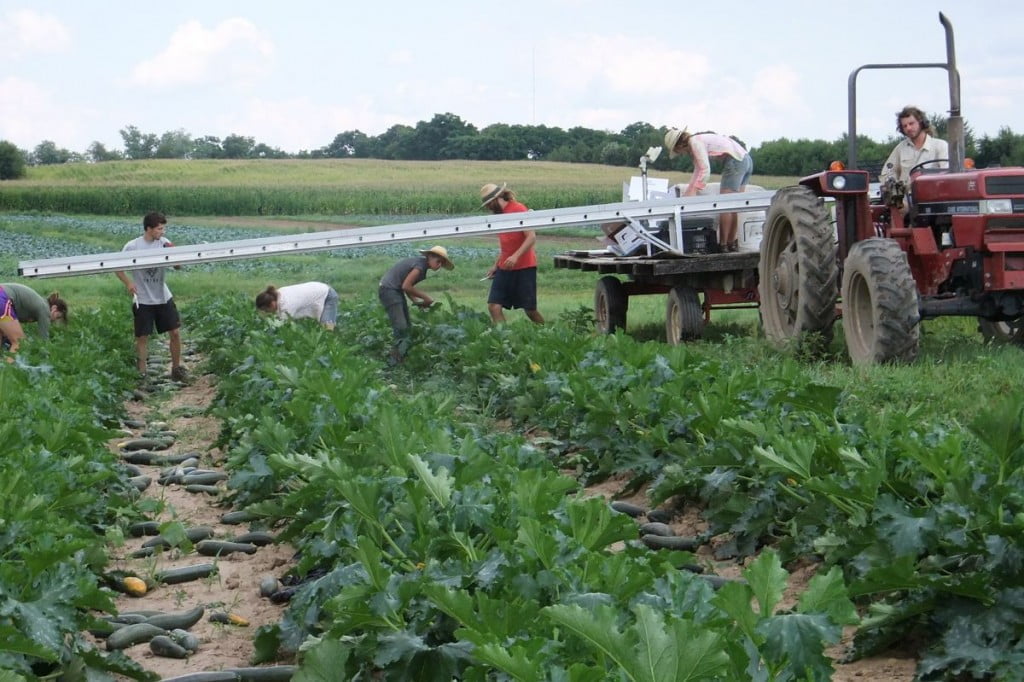
Everyone was relieved to move into planting #2. Doesn’t that look better? From left, Bri, Peter, Karen, Boi, and Clint place zucchini on the harvest belt conveyor which ferries it to the wagon. Kerry sorts and packs on the wagon. Michael drives the tractor. The squash on the ground are early, oddball ones that we cut to clean up the plants before the first harvest.
The harvest belt is one of the best investments we’ve ever made. It saves carrying squash out of the field, which saves everyone’s backs. It’s even more useful during heavy cabbage and winter squash harvests. Actually, it’s our two best investments, as this is our second harvest belt. It took ten years to wear out the first one.
Pepper feedback, please?
We’ve noticed internal problems on some of our bell peppers. We think the problem is isolated to one field, but we are not sure. We can’t open all the peppers to find out, but you can. Would you please tell us if you notice any internal problems on the peppers you receive this week, or last week? If you find problems, please send us an email titled “peppers!” with this information:
– your name,
– your pickup site,
– the week you received the pepper,
– what problem you found inside the pepper, and
– the type of pepper (red bell, yellow bell, orange bell, frying pepper, or Orano)
Thank you so much. We’d like to get this problem solved.
Please return all empty CSA boxes.
We are running low. Remember, we ask that you unpack your box and leave the empty at your pickup site each week. That keeps the boxes clean and prevents them from getting lost.
Veggie list and veggie notes (8/21/14, week #14, purple EOW)
We will send ingredients to make salsa: juicy tomatoes, cilantro, sweet onion, bell peppers and a few chiles of varied heat and flavor.
Slicing tomatoes, 5 lb
Cilantro, 1 bunch
Walla Walla onion, 1 or 2
Garlic, 1 bulb
Jalapeño (HOT), 1
‘Zavory’ habaneros (NOT HOT), 2
Bell peppers, mixed colors, probably 2
Oranos pepper, 1 or 2
Muskmelon
Romano beans OR globe eggplant OR Japanese eggplant
Cucumbers OR pickles OR Silver Slicer cukes, probably 2
Zucchini/summer squash, probably 2
Thai basil, 2 sprigs
Some members will receive one heirloom tomato. We will rotate the heirlooms among the sites as they are ready.
Next week’s box will probably contain watermelon, tomatoes, peppers, onions or leeks and more summer goodness. We’re on a roll with summer veggies!
Jalapeños (small, dark green, shiny) – The jalapeños are HOT, with estimated 5,000 Scoville units.
‘Zavory’ habaneros (small, pale green or red) – These habaneros are NOT HOT. Almost all the spice has been bred out of them, leaving a barely detectable trace of heat. Now we can all learn what habaneros actually taste like. The blazing heat always got in the way, as normal habaneros are about 200,000 Scoville units. You should still approach these chiles with caution. This is the first year we’ve grown ‘Zavory’, so we don’t know if there are off-types mixed in.
Garlic – The lovely garlic is the first harvest from our friend John Hendrickson of Stone Circle Farm.
Orano peppers (orange, tapered, sweet) – These sweet orange peppers look like frying peppers but behave more like bell peppers during cooking. They are excellent raw.
Muskmelon – Most are ripe and ready to eat. If you receive one that seems a bit green, let it ripen at room temperature for a day or two.
‘Thai Magic’ basil – This basil variety looks like Thai basil with it’s purple flowers but tastes much like Italian basil. We planted this variety because it is tolerant to a disease that’s circulating in Wisconsin this summer.
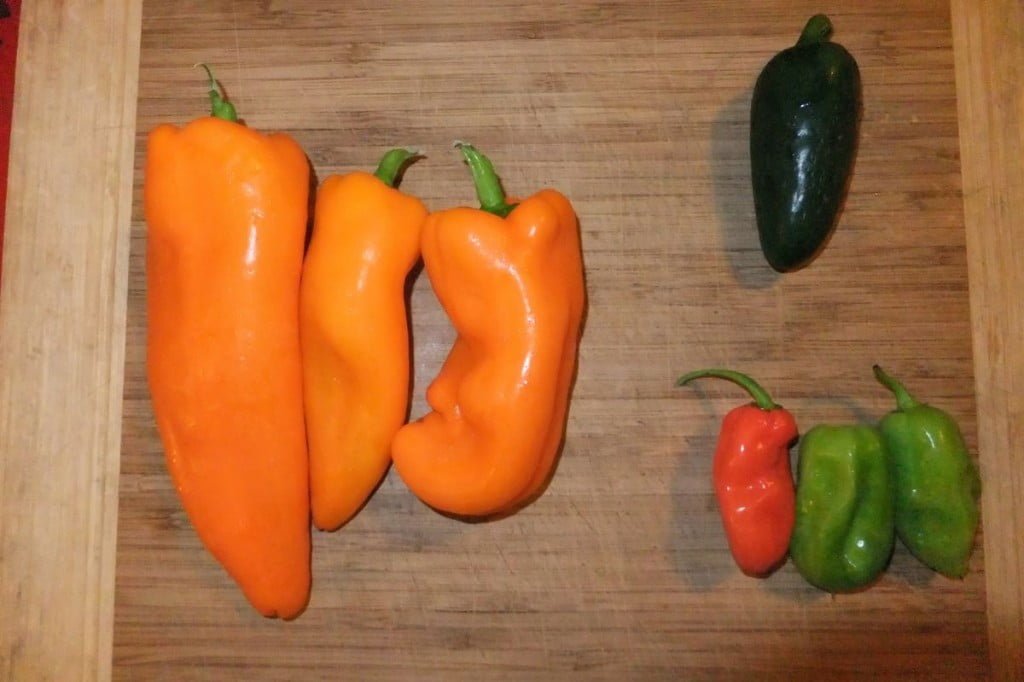
At left, Oronos (sweet); top right, jalapeño (hot); bottom right ‘Zavory’ habanero (not hot).
Our thoughts on a recent New York Times op-ed piece
- On: August 13, 2014
 0
0
Last night, our dinner conversation centered on an opinion piece in the New York Times titled “Don’t Let Your Children Grow Up To Be Farmers.” Author/farmer Bren Smith claims “The dirty secret of the food movement is that the much-celebrated small-scale farmer isn’t making a living.” It’s not true! We don’t claim that farming is easy but our farm (and others in Wisconsin) are proof that you can support a family on a small farm. Like many professions, the pay is low while you learn your skills. We lived frugally while starting and expanding our farm. We plowed our earnings back into the business for years but now we earn a middle-class income, like many of our customers.
What would we tell Bren Smith if we could talk to him?
– Don’t give up. There’s a long learning curve if you did not grow up farming. It will take time to accumulate the intuition, skills and tools that you need to be successful. Your land may need time and investment to develop too.
– Work on other farms. You will learn so much while earning a wage.
– Extend your season. It’s difficult to make a year’s income during a short growing season. Extend your work (and income) to a longer season with hoophouses or stored crops. Selling stored root crops through the winter is an important part of our farm’s stability.
– Understand that your income will fluctuate from year to year. Save during the good years.
– Farming (like every new business) requires investment. Your friends with salaried jobs do not have to invest financially in their work, but you do. That’s how it is. Be smart/cautious/frugal in your investments, including education.
– Start a food co-op. Co-ops become the hub for customers interested in local, good quality food.
– Band together with other farms in your area. Smith is correct when he writes that we need to “start our own organizations — as in generations past — and shape a vision of a new food economy that ensures that growing good food also means making a good living.” Our farmer coalition FairShare is an excellent example, in its efforts to foster the CSA marketplace in Wisconsin.
We think farming works in this region because of the consumers. That’s you, Tipi members. People in this area are willing to seek out, pay for, and eat food from small local farms. Each of those steps is a hurdle for the average customer. Whether through CSAs, farmers markets or local stores, people in this area support local farms and are rewarded with fresh, great-tasting food. Thank you all.
Beth & Steve
Sign up soon for Bike the Barns.
Bike the Barns will be held Sunday September 14. Learn more and register here. Hosted by FairShare farms, the annual ride is the primary fundraiser for our Partner Shares program. This year’s ride heads northeast from Madison, for either 45 or 60 miles. Don’t wait if you plan to join the ride. Registrations often fill by late August.
Upcoming sales of extra produce
We hope to have extra basil and extra slicing tomatoes to sell during the next month. Watch for emails from me. It will be a few more weeks before we have plum tomatoes to sell.
When should you refrigerate tomatoes?
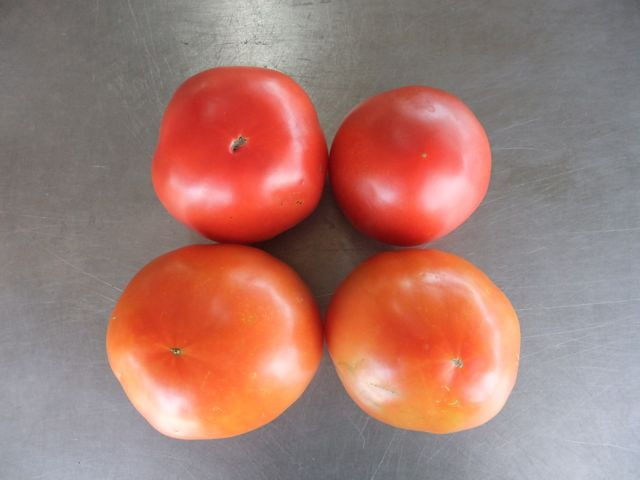
Ripe tomatoes (top) and less-ripe tomatoes (bottom).
As usual, we have packed a mix of ripe and less-ripe tomatoes so you can stretch them through the week. The top two tomatoes in the photo are ready to eat. The bottom tomatoes need to ripen at room temperature for a few days. Put on your counter or keep in a brown paper bag.
Tomatoes retain their best flavor and texture when stored at room temperature, no lower than 55oF. However, you should refrigerate your tomatoes if they are fully ripe and you don’t expect to eat them right away. It is better to sacrifice a little flavor and texture than lose your tomatoes to rot. Also, fully-ripe tomatoes are less sensitive to chilling injury.
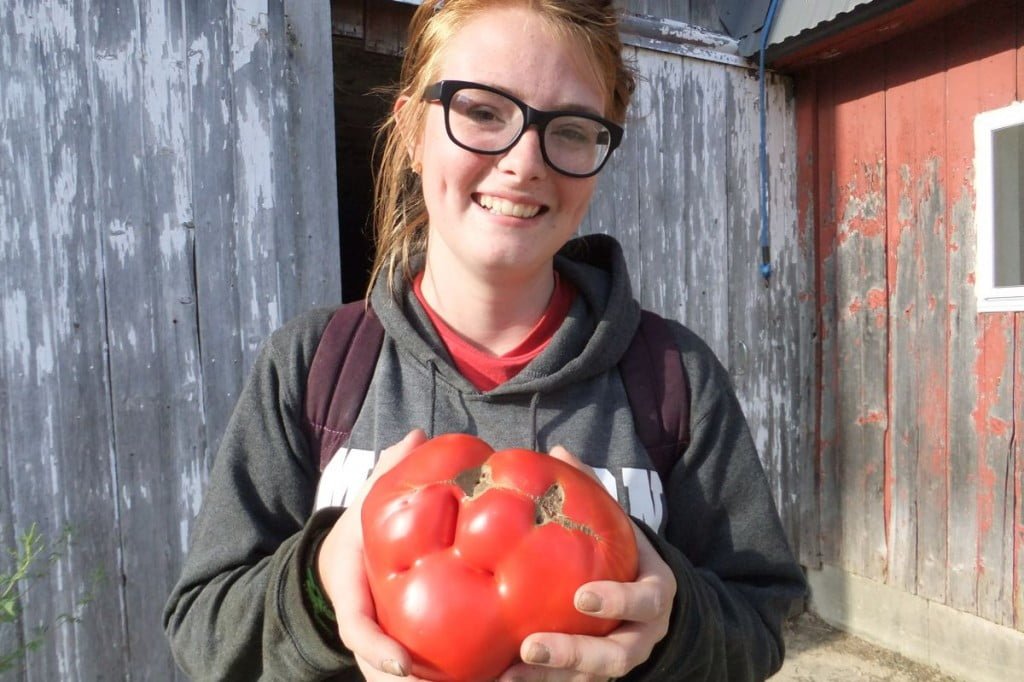
Farmhand Caitlyn holds today’s most celebrated tomato. It’s the largest tomato we picked and it looks just like an “old grandmother’s face.”
#2 Grade Red Bell Peppers
I write about pepper grading every year. Returning members can say “yeah, yeah” and skip ahead. New members, please read.
Many of the red bell peppers we send in the CSA boxes will be our #2 grade. We do this to avoid waste and to deliver good value to our CSA members. The #2 grade peppers are excellent eating quality, but are not quite pretty enough to sell to stores. As a result, we place a much lower value on these peppers. This allows us to provide generous amounts of red bell peppers over the course of the season, about three times the amount we could provide if we only gave #1 grade. We feel this is a good exchange, even if it means you occasionally open a pepper and find that it needs trimming. Here are the reasons that peppers are downgraded from #1 grade to #2 grade:
1. They may have a minor blemish, or
2. They may have minor insect damage, or
3. They may be very ripe and beginning to wrinkle. (These are especially sweet and delicious as they are fully ripe. These cannot be sold to stores because their shelf life is short. The texture is less crisp than a #1 grade pepper, but the flavor more than makes up for it.)
4. They might be partially red and partially green.
5. Others are just too small.
The eating quality is fine (or excellent) for all these #2 peppers. We throw away all peppers that we suspect have rot inside (although one may occasionally slip through in either #1 or #2 grade.) Today’s peppers are #2 grade.
Veggie list and veggie notes
Be prepared, this box is very full and very heavy. We will send everything on this list, as long as we can fit it in the box.
Sweet corn, about 10 ears
Yellow watermelon OR orange watermelon OR muskmelon
Red slicing tomatoes, 5 lb, mixed ripeness
Bell peppers (red, yellow, or orange), 1 or 2
Romano beans, 1 lb
Carrots, 2 lb
Cucumbers (1 or 2) OR pickles
Walla Walla onion, 1 or 2
Flat parsley, 1 bunch
Next week’s box will probably contain melon, tomatoes, peppers, cilantro and more summer goodness.
Sweet corn – This is a new variety, picked at its peak. It’s more creamy and less sugary than the variety we sent last week. Steve says this variety achieves the ‘old-fashioned’ flavor of the varieties he grew years ago.
Melons – Everyone will get a muskmelon (netted skin, orange flesh) or a yellow watermelon (sweet, yellow interior) or an orange watermelon (pale orange interior, sweet, tender).
Pretty edges
- On: August 06, 2014
 0
0
There are some lovely places on the lands surrounding our farm. Let’s take a look.
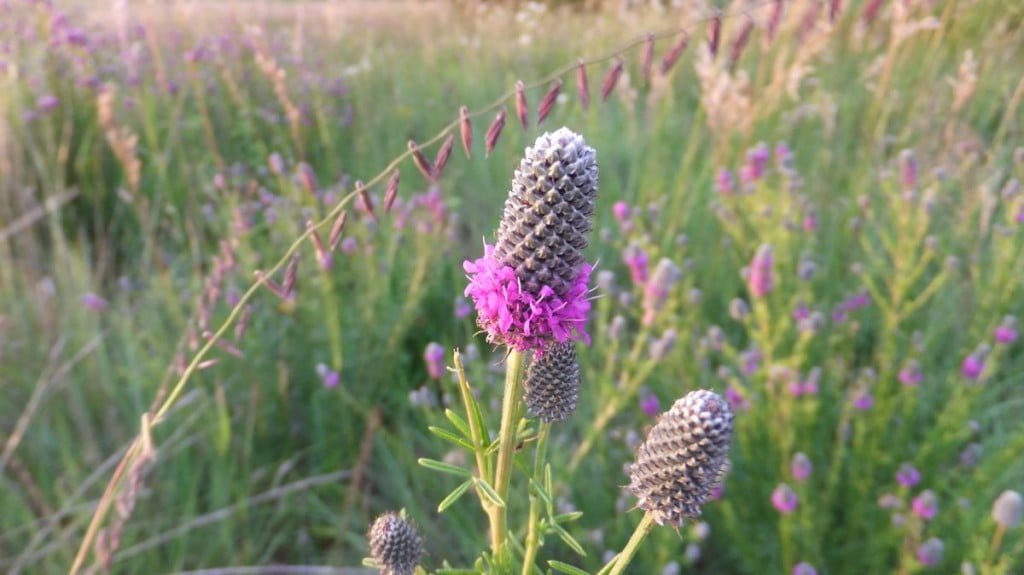
Purple prairie clover flowers, with dangling side-oats grama in the background.
Our neighbors planted a prairie strip along the border between our farms about five years ago. They said “We thought you wouldn’t mind.” They know our farm is certified organic. At 150 feet in width, the prairie strip is a substantial buffer for our crops. It’s a fascinating place to visit, even in winter.
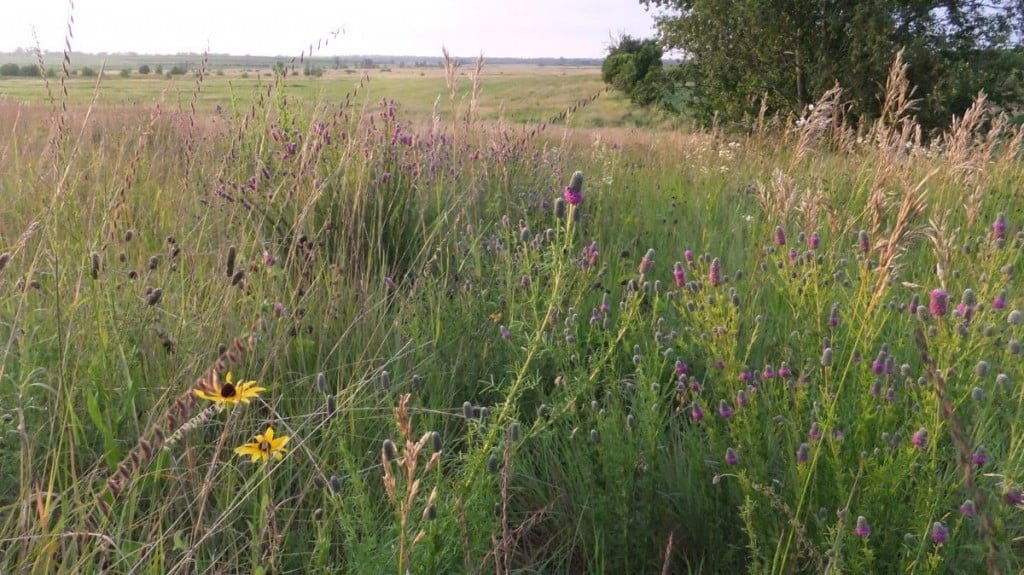
The prairie strip overlooks hunting grounds managed by the Wisconsin Department of Natural Resources (DNR).
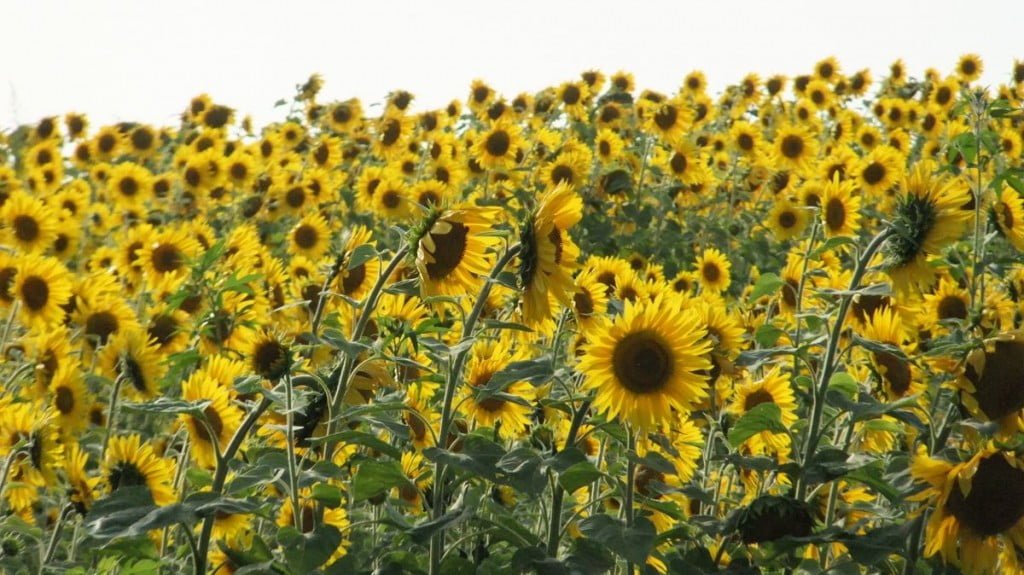
The DNR contracts with local farmers to grow sunflowers on some of those public lands. The sunflowers won’t be harvested. Instead, they will be left in the field to provide food for wildlife in fall and winter. See the DNR website for an article about annual crops that are useful for feeding wildlife. The article states that “sunflower seeds won’t last into the winter … as they are heartily feasted upon by ravenous songbirds during fall migrations.”
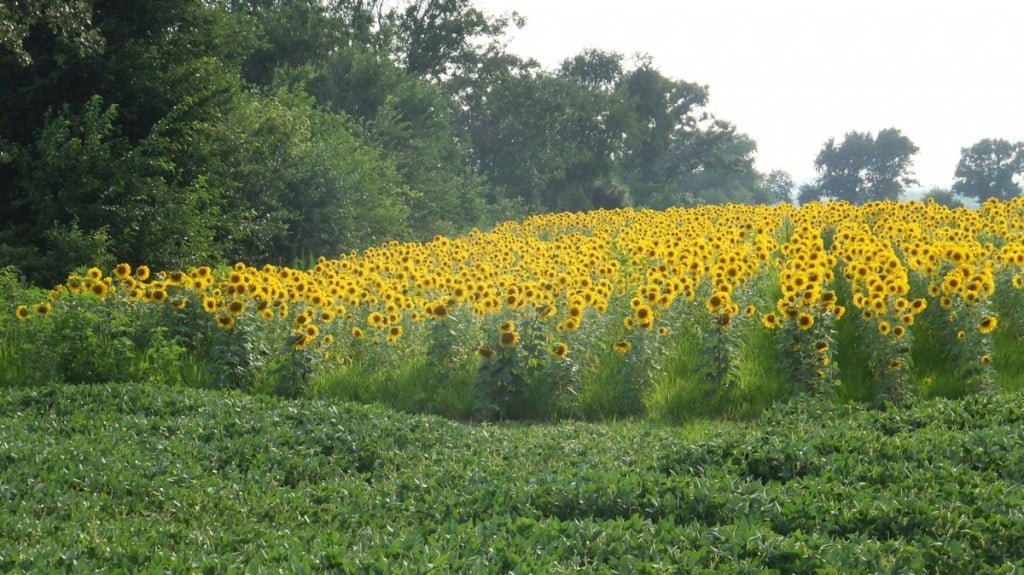
The sunflowers are so vivid at full bloom.
I’m back from vacation …
and ready to take emails again. Thank you, everyone, for limiting your emails while the kids and I were away. Steve is very busy while we are gone. It’s feels crazy to leave the farm for ten days at the height of the season. However, both our families live on the east coast. This summer trip allows our children to see their relatives more than once per year. I could not leave for that long with help from Steve and Kerry, my right-hand-woman in running the CSA. I appreciate their help so much.
Veggie List and Veggie Notes (8/7/14, week#12, purple EOW)
Red watermelon
Red slicing tomatoes, 2 to 2.5 lb
Red bell OR frying peppers, 2 or 3
Sweet corn, about 3 ears
Green beans, 1/2 lb
Carrots, 2 lb
Collards, 1 bunch
‘Summercrisp’ lettuce
White onion, 1
Red onion, 1
Cucumbers, about 2
Basil, 1 sprig
As long as we can fit them in the box, we will also send …
Zucchini & summer squash, 2 pieces
Next week, we hope to send melon, tomatoes, peppers, carrots, sweet corn, beans, onions, cucumbers, an herb and more.
Sweet corn – Much of this week’s corn is from a new planting, and the ears are on the young side. It won’t need much cooking. It was an exacting harvest and there may be some underripe ears mixed in. Our apologies in advance if you get one of them.
Collard greens – Summer greens are tougher than greens harvested during cool spring weather. Cook these longer than the spring collards.
Onions – We’ve sent a yellow Walla Walla onion for raw eating, plus a red onion for raw or cooked dishes. The red onion should fry nicely.
Cucumbers – We have a small planting of a new, white cucumber called ‘Silver Slicer.’ It is interesting and tasty. We don’t have enough for everyone this week, but we will try to distribute them to all the sites over the next few weeks.
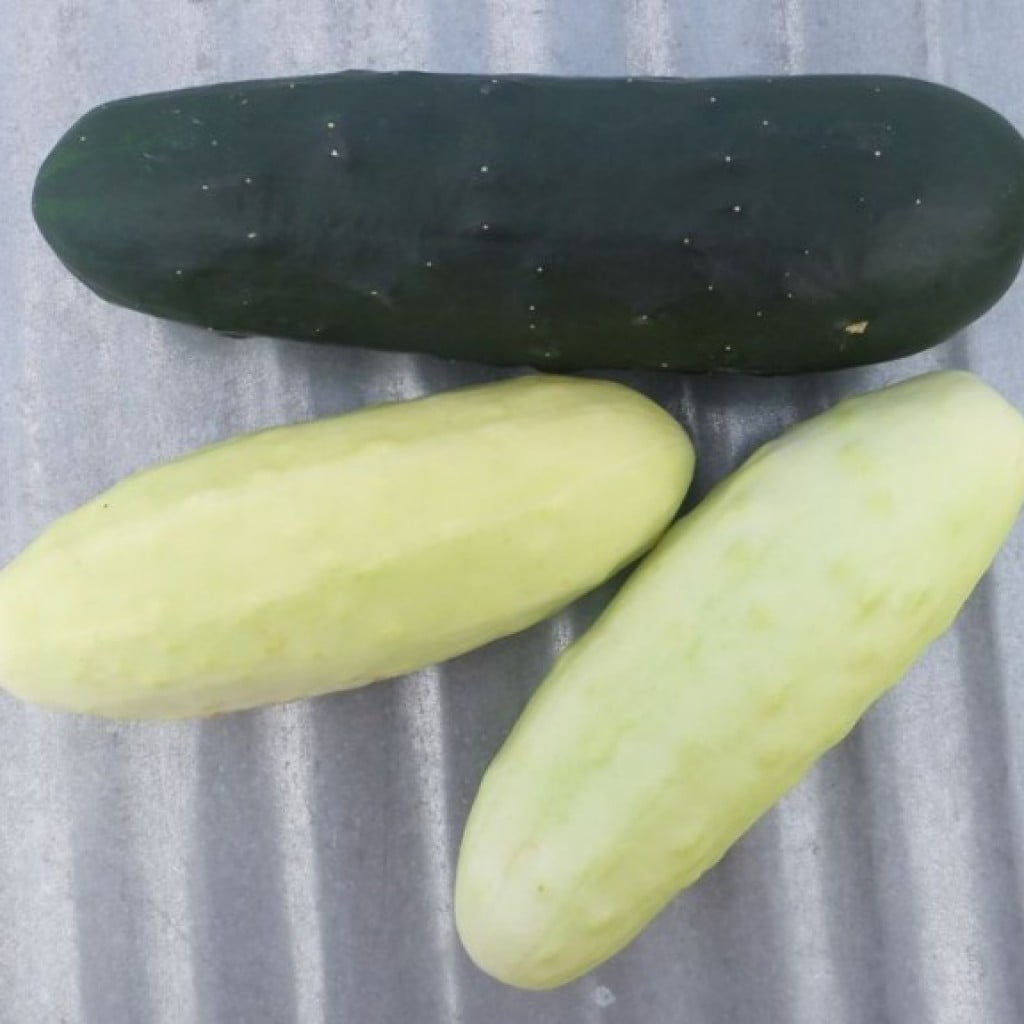
One traditional green cucumber and two ‘Silver Slicer’ cucumbers.
Veggie List (7/31/14, week #11, green EOW)
- On: August 05, 2014
 0
0
Sweet corn , 8 ears
Muskmelon OR Yellow Doll watermelon
Green beans, 1.5 lb
Cherry tomatoes, 1 pint
Red leaf lettuce
White onion, 1 large (1+ lb)
Green bell pepper, 1 large
Zucchini/summer squash, 2 lb
Cucumbers, 2
Basil
Eggplant OR broccoli OR red slicing tomatoes
Cool bug drama
- On: July 23, 2014
 0
0
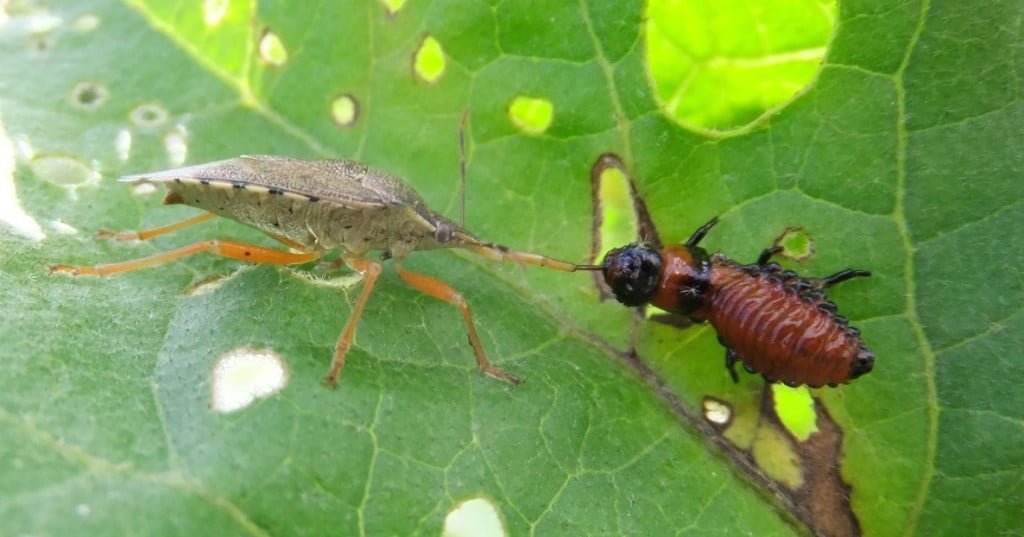
Spined soldier bug attacking a Colorado potato beetle larva.
I discovered this miniature battle among our eggplants. I was scouting for Colorado potato beetles, a pest that can defoliate eggplants. The attacking insect on the left is a spined soldier bug, a type of stinkbug. Most stinkbugs feed on (and damage) vegetables. However, the spined soldier bug feeds on other insects, especially Colorado potato beetles. This is so helpful! You can distinguish a spined soldier bug from other stinkbugs by the spines on its “shoulders.” Sucking out the brains of Colorado potato beetles is another clue. It was so cool to see this happening. This is organic agriculture at work, but it’s so easy to overlook.
CSA housekeeping
– Email brown-out from noon July 25 to August 4. I am taking our children to visit family on the east coast. We ask that you limit communication with us from July 25 through August 4. Please contact us no later than 12:00 noon on July 25 to ask questions, cancel a box, etc. Steve will check my emails but won’t have much time to respond. I’ll be back and ready to communicate on August 4. Thanks for your help with this.
– August 1 checks. Many of you paid us with checks dated August 1. I will deposit the checks on August 8.
Support a family in need.
Steve and I are members of FairShare CSA Coalition, a group of local farmers dedicated to promoting the CSA idea in Wisconsin. Our vibrant Partner Shares program supports CSA shares for low-income households. We thank each of you who donated to Partner Shares while registering for your Tipi CSA share this year. In hopes of expanding the number of families we can support next year, FairShare is holding a donation drive from July 21 through August 8. FairShare writes “We believe every family should have access to locally produced, organic food. Unfortunately, for many people, purchasing local, farm-fresh, food is beyond their means. The Partner Shares program brings fresh produce within reach for low-income families by providing up to $300 toward the cost of their CSA share.”
As you enjoy the produce we’ve grown for you, we invite you to share this experience with others in your community. Please donate to the Partner Shares program and “Share a Share” today. For more information about Partner Shares and how you can donate please visit FairShare’s website: www.csacoalition.org/news/partner-shares-donation-drive-july-21-august-8/. Thank you.
Bike the Barns registration is open but filling quickly.
Another way to support Partner Shares is by participating in the Bike the Barns bicycle tour. This year’s ride heads northeast of Madison, with two routes (45-mile, 60-mile), interesting farms, and excellent food. Read more and register here. The ride usually sells out by August 15, so you should make your decision soon.
Farm news
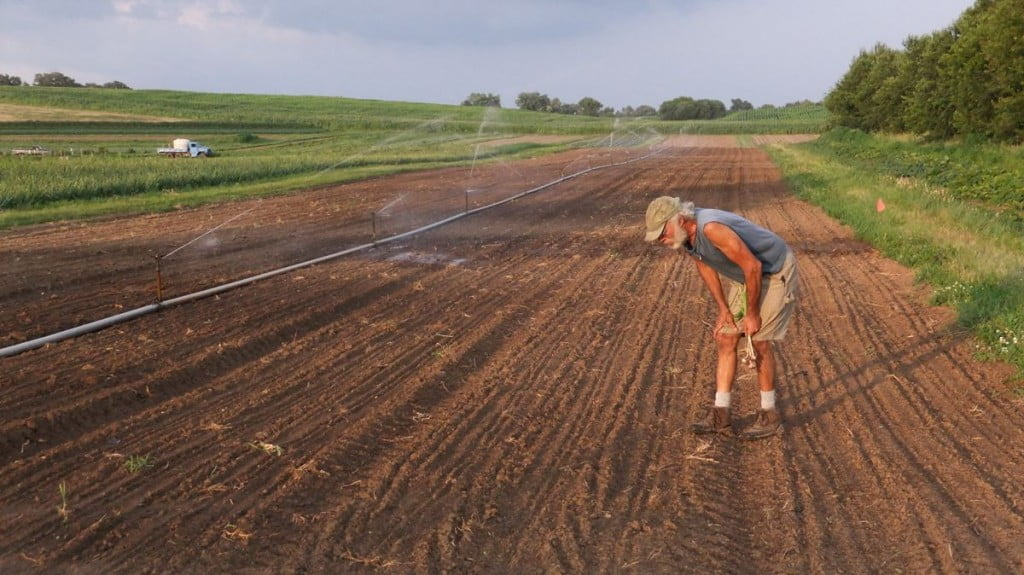
Steve irrigates a young carrot planting, and checks for emerging carrot seedlings. Carrots need to stay moist for 12 days after planting in order to germinate and emerge well. Rain is wonderful. Irrigation is reliable. We’ve had good germination in our carrot plantings this month because of the frequent rains. The carrots we plant in July will be ready to harvest in October and November. We’ll store the carrots for sale through the winter to the Willy Street, Outpost and Basics coops. I showed a photo of this exact field earlier this spring. It was planted to lettuce and scallions then.
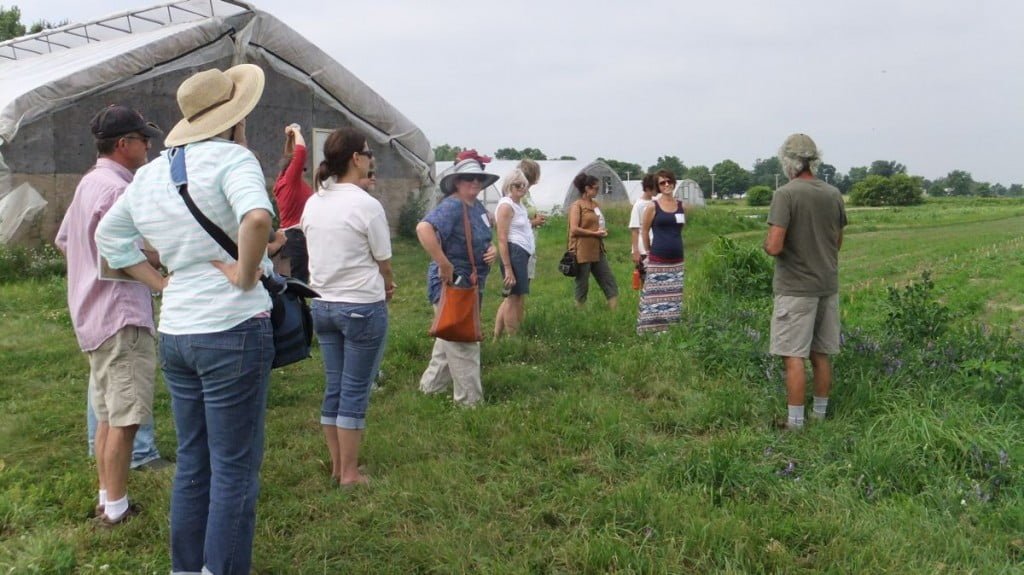
We hosted a farm tour this week for the Wisconsin Organic Advisory Council. Steve (at right) serves on the council which advises the WI Department of Agriculture on issues related to organic ag. Participants include farmers, consumers, organic advocates, business and nonprofit representatives. The group stands in front of carrot trials we’ve planted in collaboration with UW/Madison professor Erin Silva (second from right).
Veggie list and veggie notes (July 24/25, week #10, purple EOW)
Green beans, 2 lb
Broccoli, 1+ lb
Carrots, 2 lb
Kale (either green or lacinato kale), 1 bunch
Walla Walla onion, 1 large
Zucchini and summer squash, about 2.5 lb
Cucumbers, 2
Basil, several sprigs
Cherry tomatoes OR globe eggplant OR Japanese eggplant
Fresh garlic, 1 small
Next week’s box will probably contain snap beans, melon, sweet corn (?), lettuce, tomatoes, onions, zucchini, cucumbers, bell peppers, basil and more.
Fresh garlic – Refrigerate and eat soon. This young garlic won’t spoil at room temperature but will become more difficult to peel as it dries. The skins are still moist and will come off easily. At this early stage, we clean the garlic by hosing it off, and it’s still damp. We grew these heads but most of the garlic we send to you will be from John Hendrickson of Stone Circle Farm. We planted garlic ourselves this year so we can increase the amount of garlic you receive from us.
Interesting project
- On: July 16, 2014
 0
0
Last season, our tomatoes produced a bumper crop and we debated what to do with them. We sent 5 lb bags in the CSA boxes week after week. We sold bulk cases to you folks for preserving. We couldn’t bear to let them rot in the field but they were ripening very very quickly. I hunted up a small processor in East Troy called Contract Comestibles to bottle the ripe tomatoes as juice. It’s just pureed tomatoes seasoned with salt and organic onion, garlic and black pepper. We planned to send the juice in an early CSA box this year but those early boxes were full with spring crops.
This is a good moment to include it in the CSA box because you can use it as a base for soup. I made soup with sautéed zucchini, diced Walla Walla onion and minced oregano, simmered together with the juice, and topped with feta cheese. It was a quick and tasty meal with pasta. I am eager to see what Pat at Local Thyme does with it. Of course, the easiest approach is to simply drink it.
It was an interesting project for me. Farming is endlessly varied but it’s fun to tackle something new. I know a lot more about food processing now. We are curious if you consider this a valuable addition to your CSA box, and whether you think we should do this again in a bumper tomato year. Please let us know your thoughts. We’ve spanned an entire year in this box, from last year’s bottled ripe tomatoes to this year’s cherry tomatoes. I love it. Beth
Email brown-out
I am taking our children to visit family on the east coast. Steve will stay here at the farm. We ask that you limit communication with us from July 25 through August 4. Please contact us no later than noon on July 25 to ask questions, cancel a box, etc. This is an email brown-out, not a black-out. Steve will check my emails but won’t have much time to respond. I’ll be back and ready to communicate on August 4. Thanks for your help with this. Beth
Why did we sell basil last week instead of putting it in the CSA boxes?
We offered basil for sale to members last week. Several members wondered why we sold it instead of putting it in the CSA boxes. This is an excellent question.
Answer #1.
Both parsley and basil were ready to harvest, with oregano looming. We chose parsley for the CSA boxes last week because we had sent basil the week before. It takes a long time to pick those little bunches so we send one herb per week. Our expected herb sequence is basil (July 3), parsley (July 10), oregano (July 17), basil (July 24), basil (July 31). Let’s see if the plants cooperate.
Answer #2.
We have promised to sell extra basil, tomatoes and peppers to you members for preserving, when we have enough to sell. It’s a benefit of being part of our CSA. Our first priority for any crop is to provide it in your CSA boxes. When we have an abundance, we’ll offer extra for sale to members.
How do the extra produce sales work?
I will send an email to everyone when we have extra produce to sell. The email has instructions plus a link to place your order online and pay via credit card. Please order online instead of sending a request by email. It streamlines the process for us. Regular season CSA members (weekly or every-other-week) can order extra produce. A few members have asked that we give more advance warning when offering extra produce for sale. I will try to do that.
When are the next basil sales?
I hope to offer basil for sale next week (July 24/25) but won’t know until I’m sure we have enough for all the CSA boxes. Watch for an email from me mid-week.
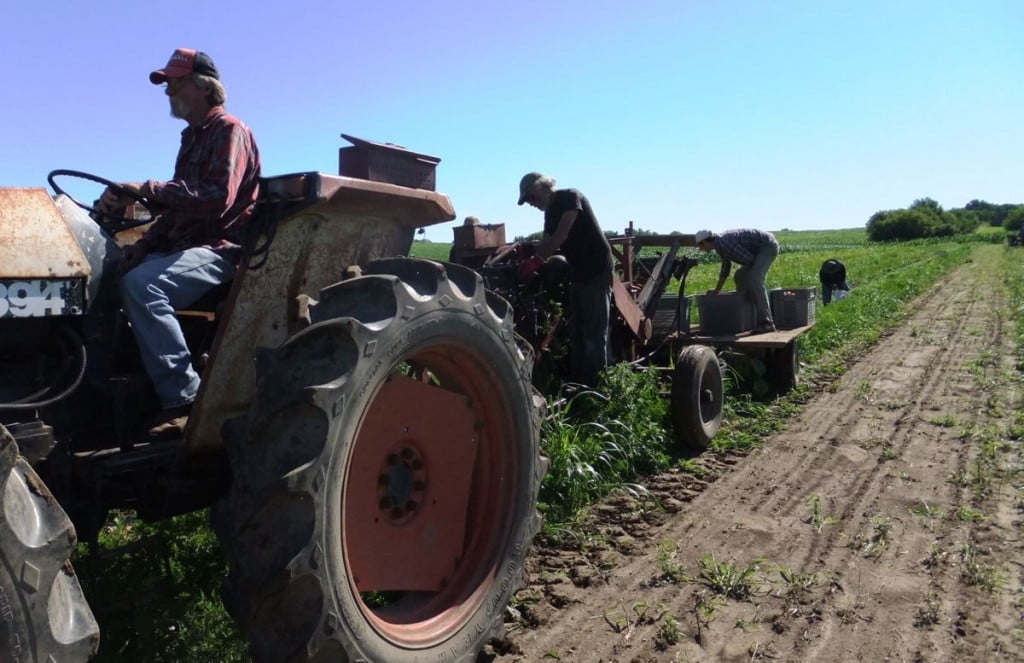
First carrot harvest of the year! From left, Larry drives the tractor, Steve guides the root harvester, John manages the carrots on the wagon and Edgar picks up missed carrots. Steve was very pleased with this first harvest.
Veggie list and veggie notes (7/17/14, week #9, green EOW)
These are our first harvests of bell peppers, oregano, carrots and beets. A few sites will get cherry tomatoes, while others will get broccoli. The cherry tomato pints are not completely full; we wanted to share these first tomatoes as widely as possible. Soon we’ll have cherry tomatoes for everyone.
- Tomato juice, 1 quart
- Carrots, 2 lb
- Beets, 1.5 lb
- Romaine lettuce
- Snap peas, 0.6 lb
- Green bell pepper, 1
- Walla Walla onion
- Zucchini & summer squash, about 2.5 lb
- Cucumbers, 2
- Oregano, 1 bunch
- Broccoli OR cherry tomatoes
Next week’s box will probably contain green beans, broccoli, carrots, kale, zucchini and summer squash, cucumbers, Walla Walla onion, garlic, basil and more.
Tomato juice – Store out of sunlight at room temperature when unopened. Refrigerate after opening. The juice is already seasoned so don’t add salt if you cook with it. I’ve listed the ingredients and nutritional information here.
Beets – Beets are excellent cooked or raw.
Storage: Cover and refrigerate. Beet roots will last for weeks. For all the cooking methods below, wash and scrub the beets but do not peel. The skins slip off easily once the beets are cooked and cooled.
Cooking beet roots on the stovetop: Slice or quarter, cover with water in a pot, and simmer until tender. This will take from 25 to 45 minutes depending on how large the beet pieces are. Drain.
Roasting beets: Wash beets, but do not peel. On a sheet of aluminum foil, put beets (halved or quartered if large), salt, pepper and a few sprinklings of water. Seal the foil packet, and roast at 400oF until tender, about 45 minutes to 1 hour. Slip off skins once cool. Microwave: Slice beets in half and place in a large microwave-proof bowl. Add ¾ inch water and cover with a plate. Microwave on high until tender, about 9-20 minutes, depending on your microwave’s power. Drain and slip off skins.
Raw: Grate raw beets for marinated salads.
Uses: Use cooked beets in cold salads, or dress simply with vinaigrette, onions, salt and pepper. Beets are also good tossed with sour cream, minced onion, fresh herbs and walnuts.
Oregano – Cover and refrigerate.
july 10 2014
- On: July 09, 2014
 0
0
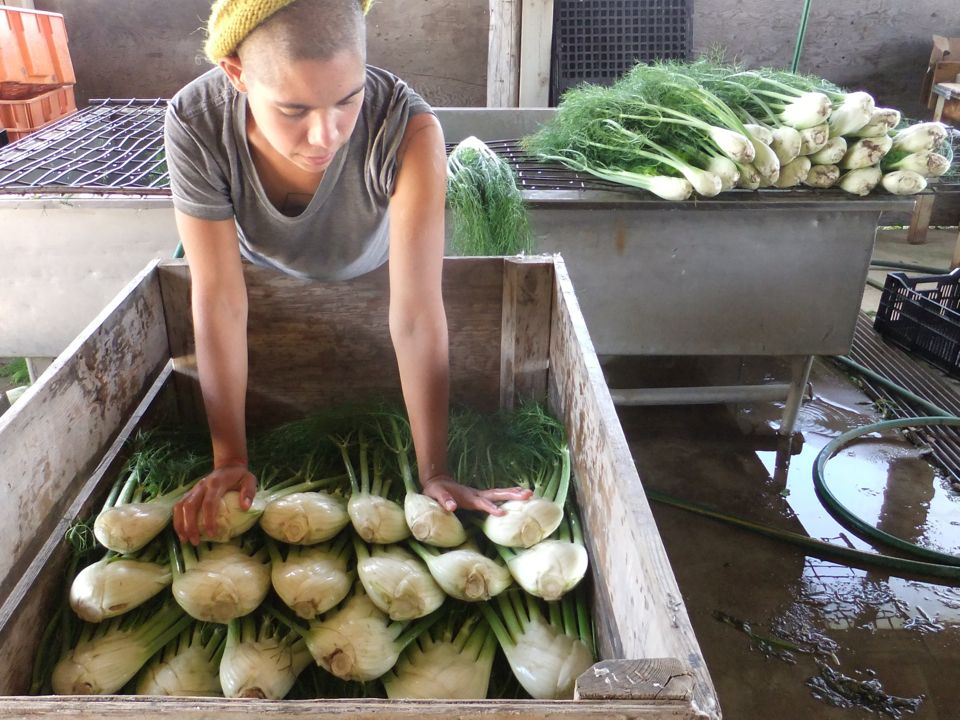
Boi washes and counts fennel for this week’s box. The frilly tops are fragrant and lovely.
What should you do when on vacation?
Let’s review how to reschedule a CSA box. This is the same information we offered in our CSA Handbook this spring. Please send complete info when you ask to reschedule a box. It’s a big help. Madison members with Honeybee bread shares, please contact Mary directly to reschedule your bread.
Tipi Vacation Policy. We understand that members go on vacation. You have three options:
1. Cancel your box. Please give us one week advance notice.
2. Have a friend pick up the box for you. Make sure he/she knows how to get the box. Give him/her the instructions for your site (see 5/9/14 email from us) so they have the directions and hours, and know how to contact your site host.
3. You can reschedule up to two boxes per season. We need one week advance notice. You must choose the replacement date at the time that you cancel the box. Send us an email with …
– the *primary name for your share
– your pick-up site
– your share type (weekly or EOW/green or EOW/purple)
– the date you want to postpone
– the new date you would like to reschedule for.
*The primary name for your share is the first name listed on the check-off sheets.
Weekly members, you will receive two boxes on the rescheduled date.
Virtual tour of our two strawberry u-picks
During every farm event, I start chatting and forget to take photos. Fortunately, you folks took pictures and are willing to share. Thank you! Here is a sampling. We were lucky that the weather stayed clear during both u-picks. As you can see in the first photo, storm clouds blew in just as the first u-pick ended.
Veggie List and Veggie Notes (7/10/14, week #8, purple EOW week)
You’ll notice a switch to summer vegetables. We hope you enjoy this box. We think it’s an especially nice one.
Cabbage, 2 to 3 lb
Swiss chard, 1 bunch
Snap peas, 3/4 lb
Snow peas, 1/4 lb
Both types of peas are in one bag.
Fennel with tops, 1
Zucchini & summer squash, 2 to 3 lb
Cucumbers, 3
Red bibb lettuce, 1 tiny
Walla Walla onion, 1
Parsley, 1 generous bunch
Next week’s box will probably contain beets with greens, carrots, peas, Walla Walla onion, zucchini, cucumbers, kale, herbs and more.
Cabbage – This is another head of salad-type cabbage. These have thinner, more tender leaves than the usual green cabbage. Great in salads and slaws but can also be cooked.
Fennel (large vegetable with a fat bulb and lacy fronds) – Fennel is a ‘swing vegetable’; it can be used raw or cooked. Clean well and slice as thinly as possible for use in raw salads. It is good simply prepared with olive oil, lime or lemon juice, salt and shaved parmesan cheese. Cooking softens and sweetens fennel, and mellows its anise flavor. Both the bulb and leaves are edible. Here are ideas from Alice Water of Chez Panisse about how to use fennel: ‘It’s strong anise characteristic seems to suit fish particularly well. … We use fennel all the time. We add the feathery leaves to marinades for fish and to numerous salads, sauces and soups and we use them as a garnish, too. … The bulbs are sliced and served raw in salads in various combinations with other vegetables, parboiled for pastas; caramelized and served as a side dish; braised whole; or cooked in vegetable broths & fish stocks.”
Red bibb lettuce – These heads are tiny but very nice. We harvested them young because it’s risky to leave them in the field in wet weather. They should be useful in a mixed salad or as a bed for marinated vegetables.
Walla Walla onions – These are sweet onions, like Vidalias. Wonderful raw or lightly cooked. This week’s onions are unusually plump for this time of year.
What do farmers do during rainy weather?
- On: July 02, 2014
 0
0
It’s been too wet for field work this week. We harvest your veggies rain-or-shine, but can’t take tractors in the fields when the ground is too muddy. Steve spent his time buying more irrigation pipe. How ironic is that, to work on irrigation during a monsoon? We will enjoy the new pipe; it will allow us to irrigate five big carrot fields (over 3 acres) at once without moving pipe. This is a big improvement. Of course, the carrots are not planted yet because the ground is too wet.

Steve with our new irrigation pipe.

The business end of the pipe although, as Steve says, “it’s really good to have both ends.”
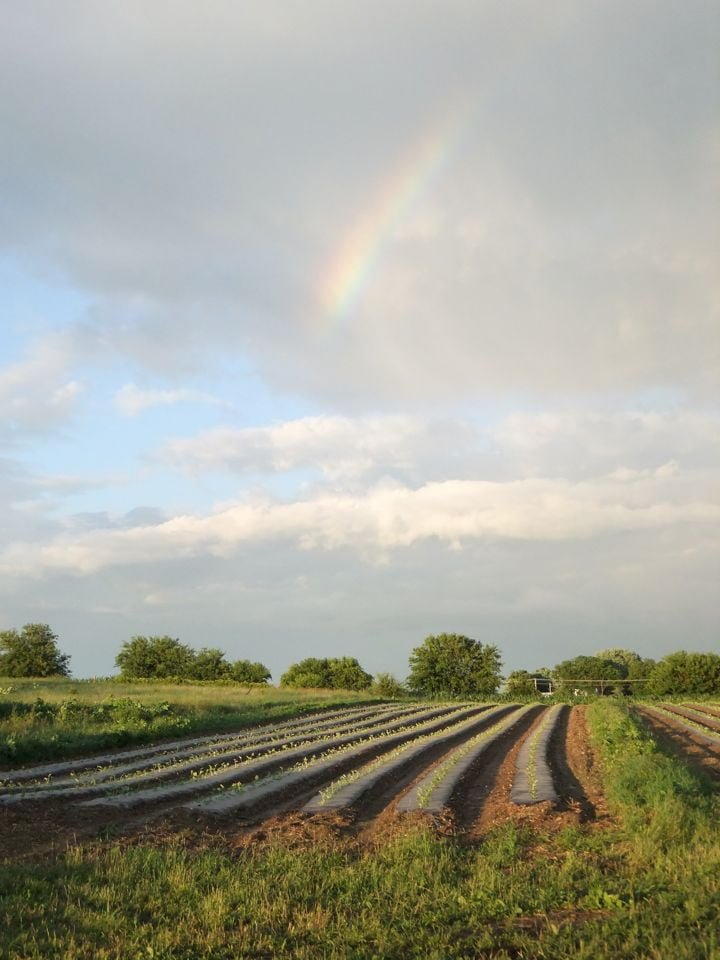
A sunny moment between rain storms.
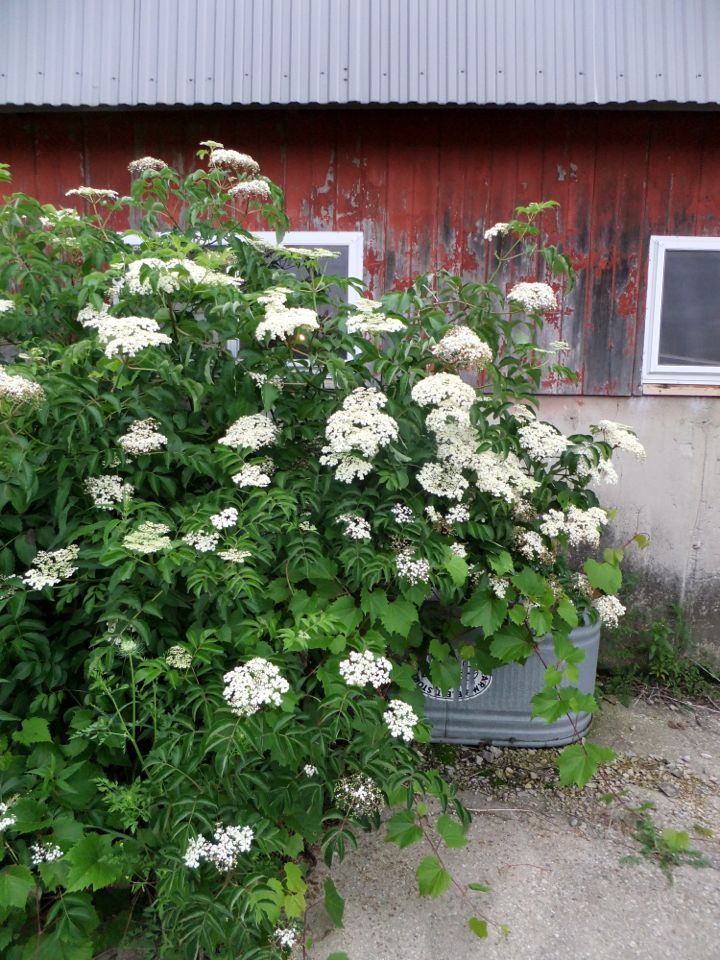
The elderberry bushes are spectacular this year.

Every bride should carry lacy elderberry blossoms, never mind the funky smell.
Veggie List and Veggie Notes (week #7, green EOW)
We enjoyed the strawberry u-pick on Sunday. Lots of members came to pick berries and wander the farm. Fortunately, the u-pick berries ripened during somewhat drier weather. Sadly, pounding rainstorms on Sunday night and Monday damaged the late berries. That ends our strawberry season.
We’ve sent a lot of squash and cucumbers because the plants were remarkably productive this week. Our bees did not visit (or pollinate) our squash plants for a long time because of rainy or windy weather. Once the plants got pollinated during dry spells, they exploded with rapid squash growth. Same thing happened with the cucumbers. Grilled squash and cucumber salad are great 4th of July dishes. Enjoy!
Snap peas, 1.4 lb
Broccoli, 1 head
Zucchini & summer squash, 3 – 3.5 lb
Cucumbers, 4
Collard greens, 1 bunch
Green leaf lettuce, 1 small
Kohlrabi, 1
Scallions, 1 large bunch
Basil, 1 sprig
Next week’s box will probably contain cabbage, zucchini, fennel, parsley, cucumbers, lettuce, scallions OR Walla Walla onions, and more.
Basil (curly-leaved sprig) – This is the variety ‘Napoletano.’ The leaves are larger and more frilly than most basils. We like this variety because the its leaves remain tender and flavorful even as the plants mature. Basil will blacken if stored in the refrigerator. It is best stored at room temperature with the cut ends in water, for example in a glass or teacup. Give the stem a fresh trim. You will receive one sturdy stem this week. We snipped these sprigs to shape the plants. They are a bit tattered from the recent rains but taste (and smell) great.
Green leaf lettuce – The lettuce are quite small. We harvested them young while they are still good. It’s a good strategy during wet or hot weather.


